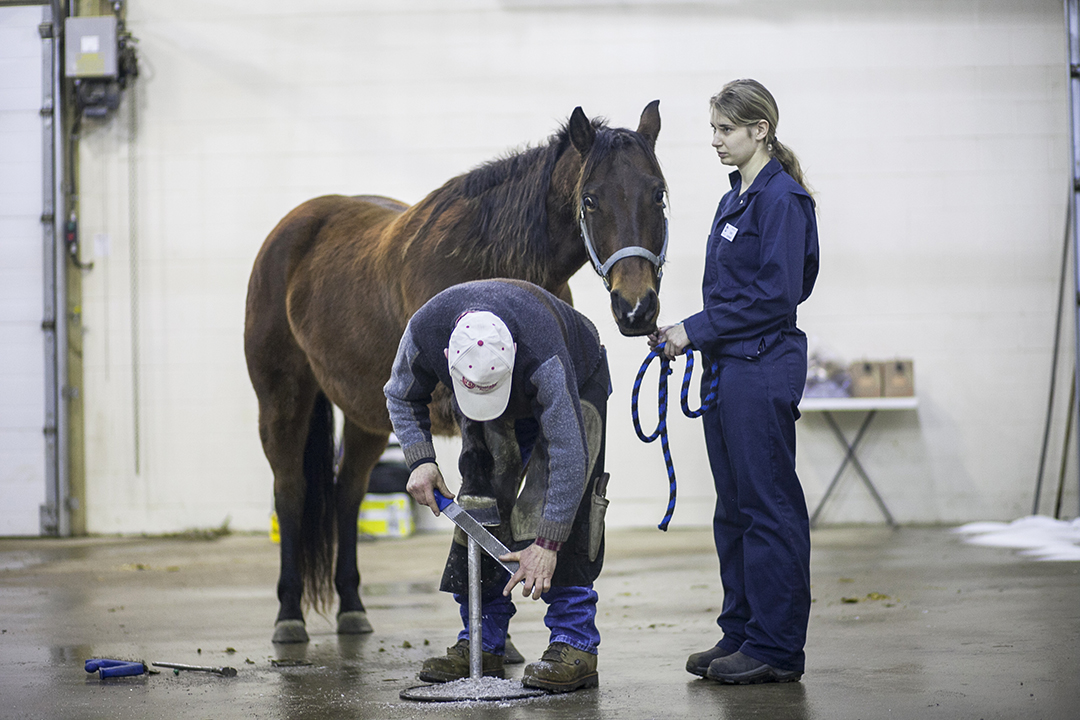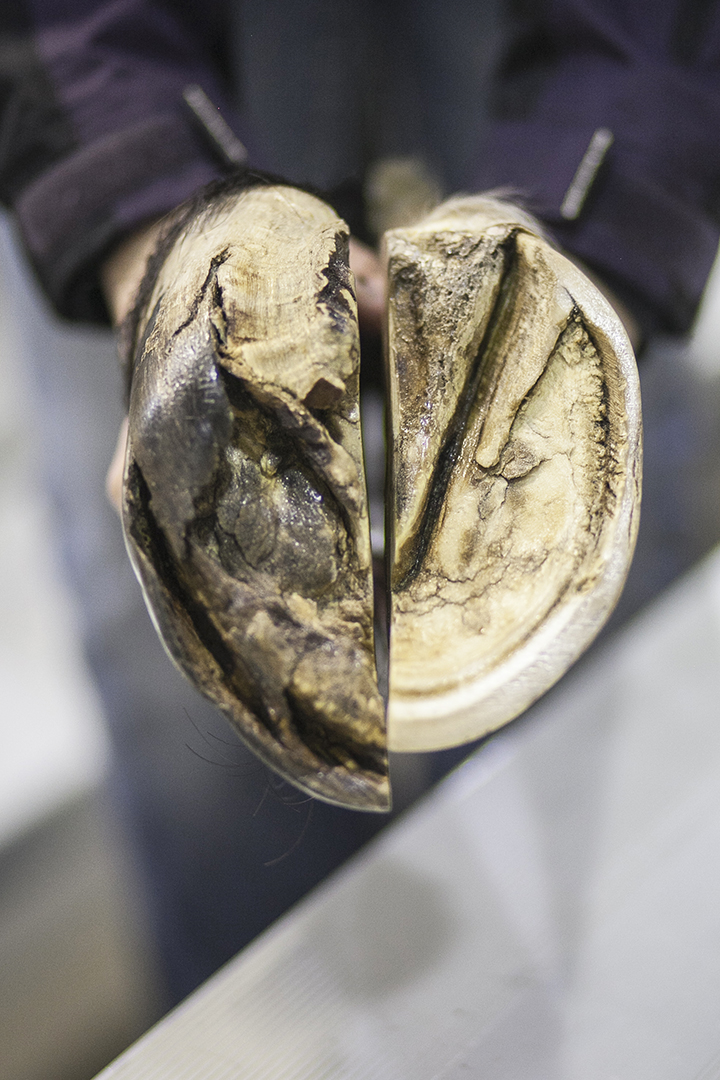
Bowker brings expertise in equine foot health to WCVM
This fall, members of the local horse community and students at the Western College of Veterinary Medicine (WCVM) will have the chance to learn about a novel approach to equine foot health straight from the man who developed the theory.
By Lynne Gunville
Dr. Robert Bowker, director of the Equine Foot Laboratory at Michigan State University (MSU), and an internationally-acclaimed authority on equine foot health, is giving a sold-out workshop called “A foundation for soundness: understanding and creating a functional hoof” on Oct. 24 and 25 at the WCVM.
Bowker, a professor emeritus of anatomy at MSU, will present his findings about the structure and function of the equine hoof as well as his recommendations for preventing, treating and rehabilitating hoof problems such as caudal heel pain, also known as navicular syndrome.
“Just his approach and his insight is groundbreaking and different from the way that a lot of us were taught to think about the foot,” says Dr. Kate Robinson, an assistant professor in the WCVM’s Department of Large Animal Clinical Sciences.
Bowker’s recommendations are based on years of scientific research focused on studying the functional anatomy of the equine foot in domestic and wild horses. After recognizing the key role that blood flow plays to dissipate energy in the foot when it hits the ground, he developed a new theory that was markedly different from the established beliefs about the foot’s response to impact.
That theory has led to unique recommendations for trimming the hoof — a technique Bowker refers to as the physiological trim. He advises that the back part of the foot, including the frog, should hit the ground first. The frog should also maintain contact with the ground when the foot is weighted. Trimming this way aims to optimize the effects of impact so that the foot is stimulated to produce more tissue in that area. That extra tissue has been shown to protect against some of the chronic foot problems that can lead to lameness.
This hoof trimming method also results in the impact being distributed over the largest part of the foot. Bowker compares this distribution of weight to that which occurs when a human wears sneakers rather than high-heeled shoes. When the impact is spread over a larger area, there is reduced stress on the foot.
In addition to demonstrating the physiological trim to workshop participants, Bowker will describe the difference between a horse with good, healthy feet and one with poor feet that’s likely to experience some common foot problems.
Bowker will also offer his advice on how to help prevent common foot problems. Drawing on his knowledge of how trimming and management practices affect the foot, he will advise on strategies for rehabilitating horses that are already showing signs of foot issues such as navicular syndrome — a condition that causes pain in the heel region.
“Navicular syndrome is typically thought to be a problem with the rear of the foot, but Bob views it as a whole foot problem,” says Dr. Yolande Seddon, an assistant professor at the WCVM who has first-hand experience with Bowker’s rehabilitation methods. She recently consulted him about her two-and-half-year-old mare diagnosed with early-stage navicular syndrome.
“Through his research findings, Bob identified that the equine foot is constantly adapting to stimulation from the environment, and that our trimming and management practices influence the health of the internal foot structures,” says Seddon. “Taking this knowledge, he developed theories and approaches to improve the health of the foot structures that can support prevention of pathologies such as navicular syndrome.”
Since consulting Bowker, Seddon has diligently followed his advice that can be summarized as physiological trimming at regular intervals and movement on surfaces that the horse finds comfortable. Months of rehabilitation has achieved substantial, beneficial changes to the mare’s hoof form and function in accordance with Bowker’s theories — transforming an underrun, non-functional heel into a more functional heel and increasing the firmness of the tissue in the back part of the mare’s foot.
“The mare is now very comfortable on her forefeet, but not yet fully recovered — her feet continue to develop in the right direction,” says Seddon. She has documented the changes in her mare’s feet, and she’s confident that Bowker’s strategy is working.
“Bob is so knowledgeable about the horse’s foot. His approach is to use the knowledge on the functional anatomy of the foot to grow healthier feet,” she explains.
Seddon’s specialty at the WCVM is swine behaviour and welfare, but she has always had a great interest in horses. As a researcher, she appreciates the science behind Bowker’s theories as well as his expertise at presenting the information so it’s easy to understand and apply. She considers that his approaches have important implications for improving horse welfare.
Since hoof problems are a common issue facing veterinarians, Bowker’s workshop can provide them with additional information on preventive management and options for treatment — perhaps a combination of his rehabilitation strategies with other therapies such as pain medication and shock wave therapy.
For horse owners, the workshop will offer a different perspective on hoof care, including alternative trimming practices and management to optimize foot function and health.
Bowker’s presentation will also benefit farriers by providing recommendations for trimming the hoof to prevent future problems and advice on how to turn a bad foot into a good foot.
“Our farriers and our trimmers are our go-to people,” explains Robinson. “A lot of times they know the horses better than the veterinarians do because they’re seeing them on a much more regular basis. They’re the ones who can implement the foot care and work with the owner to try and maintain a healthy foot for their horse.”
She adds that treating a specific hoof problem requires months of rehabilitation and an intensive treatment program, so its success depends on the buy-in and the co-operation of the owner and the farrier or trimmer along with the veterinarian.
Seddon is particularly pleased that WCVM students will have an opportunity to attend the workshop and learn from Bowker. “They are the next generation of veterinarians. This information can go fresh into their heads, and then they can go forward and think about it in their training.”
Robinson adds that it’s important for the WCVM to host these types of quality workshops that benefit everyone in the horse community.
“We at the WCVM are here to dispense knowledge, whether that be to our students, to vet colleagues in private practice or to the animal-owning public,” says Robinson. “I think that universities and colleges exist as the knowledge dispensary, and I think we need to uphold that through workshops such as this one.”
Dr. Robert Bowker will also give a public lecture from 12:30 to 1:30 p.m. on Tuesday, Oct. 23, as part of the D.L.T. Smith Lecture series at the WCVM. The one-hour presentation will take place in Room 2115 at the veterinary college.
